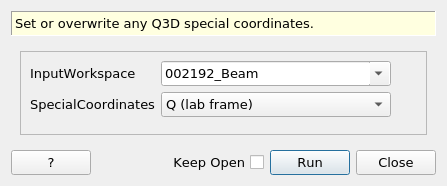\(\renewcommand\AA{\unicode{x212B}}\)
SetSpecialCoordinates v1¶

SetSpecialCoordinates dialog.¶
Summary¶
Set or overwrite any Q3D special coordinates.
See Also¶
Properties¶
Name |
Direction |
Type |
Default |
Description |
|---|---|---|---|---|
InputWorkspace |
InOut |
Mandatory |
An input/output workspace. The new log will be added to it. Important Note: This has now only an effect on PeaksWorkspaces. MDEvent and MDHisto worksapces are not affaceted by this algorithm |
|
SpecialCoordinates |
Input |
string |
Q (lab frame) |
What will be the dimensions of the output workspace? Q (lab frame): Wave-vector change of the lattice in the lab frame. Q (sample frame): Wave-vector change of the lattice in the frame of the sample (taking out goniometer rotation). HKL: Use the sample’s UB matrix to convert to crystal’s HKL indices. Allowed values: [‘Q (lab frame)’, ‘Q (sample frame)’, ‘HKL’] |
Description¶
MDEventWorkspaces and MDHistoWorkspaces can be used with any type of coordinate system. On the other hand PeaksWorkspaces may be plotted either in QLab, QSample or HKL. There is an inherent link between a PeaksWorkspace and a MDWorkspace in that an MDWorkspace may utilise the same coordinate systems as the PeaksWorkspaces. For example, workspaces created via ConvertToMD v1 or ConvertToDiffractionMDWorkspace v3 may be generated in a special set of V3D coordinates, which are the same as those for the PeaksWorkspace (QLab, QSample, HKL). Amongst other usages, in order to be able to simultaneously plot MDWorkspaces and PeaksWorkspaces, it is necessary to be able to determine what (if any) special coordinates the Workspaces were created in, or are currently using.
This algorithm is for backwards compatibility. The special coordinates flags are new, and legacy workspaces will need to be corrected in order for them to work as expected with the Mantid tools.
Categories: AlgorithmIndex | Crystal\Corrections
Source¶
C++ header: SetSpecialCoordinates.h
C++ source: SetSpecialCoordinates.cpp
